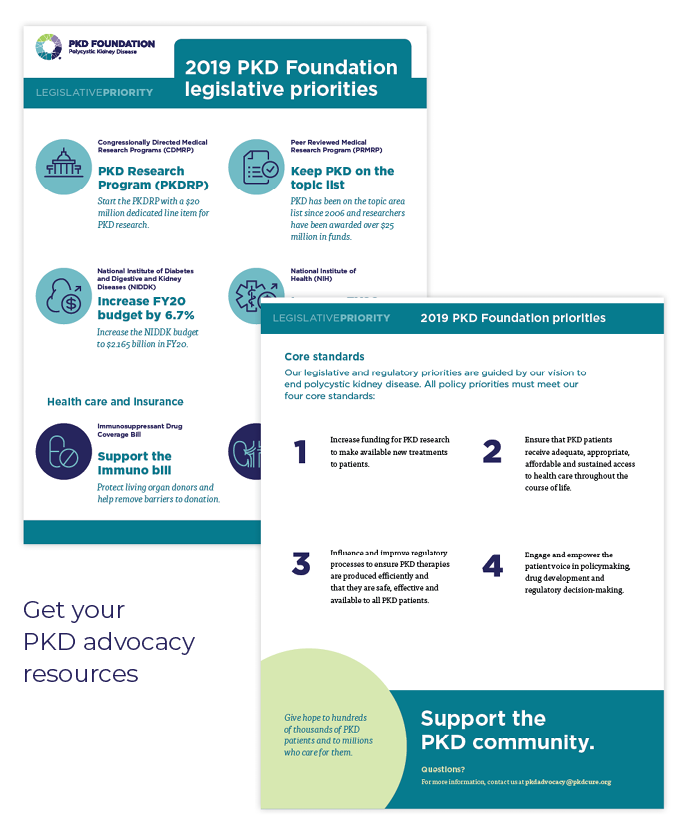As lawmakers get ready to return from the August recess, PKD Foundation sat down with Alexis Denny, Director of Government Affairs, to learn more about the intricacies of the general Federal Budget process and how it pertains to the PKD community and the PKD Foundation’s 2019 Advocacy Plan.

“The most important part of my work is advocating for federal dollars to support PKD research,” Alexis says. “All of that funding has to be budgeted and appropriated each year, so understanding the federal budget process is critical to understanding how to increase support for research.”
Funding the government
All federal dollars for research, healthcare and drug development are appropriated through the federal budget. Agencies such as the following cannot spend money without a budget.
- National Institutes of Health (NIH)
- Food and Drug Administration (FDA), Health and Human Services (HHS)
- Veterans Administration (VA)
- Department of Defense (DOD)
Each year, Congress must pass a budget in order to fund the government for the next year. The federal fiscal year runs October 1 – September 30.
Budgeting timeline of events
February — The annual budget process generally begins when the administration releases its budget proposal outlining the current administration’s priorities for revenue (taxes), new policies and proposed changes to current law.
March — Early in the month, pertinent congressional committees conduct targeted meetings called hearings on the budget proposal. The House and Senate Budget Committees are tasked with drafting a budget resolution to guide Congress in its constitutional responsibility of funding federal activities. A budget resolution does not have to accept each of the suggestions in the administration’s proposed budget. Congress can modify, reject or add to the administration’s budget.
Glossary of terms
Authorizing Committees — committees that consider bills and issues and oversee agencies, programs, and activities within their jurisdictions
Budget Resolution — adopted by both houses of the U.S. to set forth, reaffirm or revisit the budget for a fiscal year
Conference Committee — created after the House and the Senate pass different versions of a piece of legislation
Debt Ceiling — limit that Congress imposes on how much debt the federal government can carry at any given time
Discretionary Programs — represent special funding categories used to select projects for funding based on applications received
Filibuster — tactics such as long speeches used to delay or prevent action especially in a legislative assembly
Minibus Legislation — include a smaller number of the appropriation measures
Omnibus Legislation — include a larger number of the appropriation measures
Reconciliation — legislative process of Congress that allows expedited passage of certain budgetary legislation on spending, revenues, and the federal debt limit with a simple majority vote in both the House and Senate
A budget resolution often includes instructions for a process called reconciliation. Committees are instructed to approve legislation making changes to tax, defense and/or domestic spending programs. The committees’ proposals are then packaged into a single bill. Reconciliation provides the Senate with the opportunity to avoid a filibuster and approve major policy changes by a simple majority vote.
March and April — During the spring, committees in the House and Senate conduct their own reviews of the budget proposal. Authorizing committees such as the House Committee on Energy & Commerce and the Senate HELP (Health, Education, Labor and Pension) Committee determine what changes need to be made to existing programs such as health insurance. The Senate Finance and House Ways & Means Committees determine if additional revenue is required. Both committees also have health-related duties, primarily Medicare and Medicaid.
The Appropriations Committees determine how much money will be available for specific programs. These committees decide how to allocate federal revenues for discretionary programs that must be funded every year. Hearings before these committees take a close look at individual programs to determine if additional money is needed to carry out a program’s responsibilities.
May — The Appropriations Committees begin writing 12 bills to fund all activities of the federal government. The PKD Foundation pays close attention to the work of the Labor/Health and Human Services (HHS)/Education and the Defense Subcommittees. PKD research funding comes from these two subcommittees (NIDDK funding comes from LaborH — Labor, Health and Human Services and Education committees), while Congressionally Directed Medical Research Programs, or CDMRP, funding comes from Defense).
June and July — The House and Senate debate and approve their respective funding bills. If differences exist between the House and Senate bills, a conference committee meets to draft a bill acceptable to both the House and Senate.
September — Congress passes all the funding bills, and the President will sign them into law. This completes the budget process and funding the government for the next fiscal year, beginning October 1. Congress rarely approves all 12 bills individually. Some bills are combined into what is known as a “minibus.” Sometimes, packaging bills together can speed up their approval process. Occasionally, when Congress and the White House cannot agree on spending, all appropriations are combined into a single “omnibus appropriations” bill.
October — The budget must be written, adjusted, finalized and signed into law by October 1 of that year. Once Congress completes work on the fiscal year beginning October 1, it prepares for the next budget proposal to arrive the following February.
Alternatives, if not funded by Oct. 1
If Congress does not approve all 12 appropriations bills by the end of September, there are several alternatives:
Continuing Resolution — A Continuing Resolution (CR) permits continued government activities under the current budget. No new programs can be started while a final appropriations bill is drafted and signed into law. A CR can last as briefly as a few days or an entire fiscal year.
Shutdown — If the President rejects a spending bill to keep open some or all federal activities, the government could shut down. A few departments and “essential” activities will continue working, such as national security activities. However, “non-essential” programs cease, and workers are furloughed or laid-off. In the past, NIH and FDA fell into the non-essential category, meaning that those agencies were furloughed. Previous shutdowns have lasted from a few days to more than a month.
Other considerations
One issue that arises periodically is the federal debt ceiling. The US Treasury borrows money that enable federal departments and agencies to pay their obligations: salaries, grants, etc. The federal debt limit law determines how much the Treasury can borrow. Once that limit is reached, Treasury cannot borrow or spend any more money to pay contractors for past work. An agreement on increasing the debt ceiling usually occurs as part of a general budget agreement determining defense and non-defense spending levels.
If you’d like to get involved in Advocacy with the PKD Foundation, sign up for our advocacy alert emails!









0 Comments